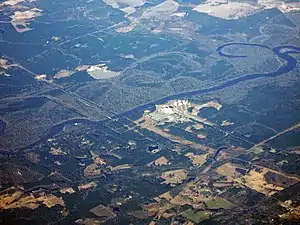Edwin I. Hatch Nuclear Power Plant
The Edwin Irby Hatch Nuclear Power Plant is near Baxley, Georgia, in the southeastern United States, on a 2,244-acre (9 km²) site. It has two General Electric boiling water reactors with a total capacity of 1,848 megawatts. Previously, the reactors had a combined capacity listing of 1,759 MW. Unit 1 went online in 1974 and was followed by Unit 2 in 1978. The plant was named for Edwin I. Hatch, president of Georgia Power from 1963 to 1975, and chairman from 1975 to 1978.
| Edwin I. Hatch Nuclear Power Plant | |
|---|---|
 E. I. Hatch Nuclear Power Plant near Baxley, Georgia. | |

| |
| Country | United States |
| Location | Baxley, Appling County, Georgia |
| Coordinates | 31°56′3″N 82°20′38″W |
| Status | Operational |
| Construction began | Unit 1: September 30, 1968 Unit 2: February 1, 1972 |
| Commission date | Unit 1: December 31, 1975 Unit 2: September 5, 1979 |
| Construction cost | $3.214 billion (2007 USD)[1] |
| Owner(s) | Georgia Power (50.1%) OPC (30%) MEAG (17.7%) Dalton Utilities (2.2%) |
| Operator(s) | Southern Nuclear |
| Nuclear power station | |
| Reactor type | BWR |
| Reactor supplier | General Electric |
| Cooling towers | 6 × Mechanical Draft |
| Cooling source | Altamaha River |
| Thermal capacity | 2 × 2804 MWth |
| Power generation | |
| Units operational | 1 × 876 MW 1 × 883 MW |
| Make and model | BWR-4 (Mark 1) |
| Nameplate capacity | 1759 MW |
| Capacity factor | 94.30% (2017) 81.25% (lifetime) |
| Annual net output | 14,531 GWh (2017) |
| External links | |
| Website | Plant Hatch |
| Commons | Related media on Commons |
In 2002, the Nuclear Regulatory Commission (NRC) extended the operating licenses for both reactors for an additional twenty years.
Ownership
The Hatch plant is operated by Southern Nuclear Operating Company, a subsidiary of Southern Company. Hatch's owners are:
- Georgia Power (50.1%) (also a Southern Company subsidiary)
- Oglethorpe Power Corporation (30%)
- Municipal Electric Authority of Georgia (17.7%)
- Dalton Water & Light Sinking Fund Commission (2.2%)
Surrounding population
The Nuclear Regulatory Commission defines two emergency planning zones around nuclear power plants: a plume exposure pathway zone with a radius of 10 miles (16 km), concerned primarily with exposure to, and inhalation of, airborne radioactive contamination, and an ingestion pathway zone of about 50 miles (80 km), concerned primarily with ingestion of food and liquid contaminated by radioactivity.[2]
The 2010 U.S. population within 10 miles (16 km) of Hatch was 11,061, an increase of 6.7 percent in a decade, according to an analysis of U.S. Census data for msnbc.com. The 2010 U.S. population within 50 miles (80 km) was 424,741, an increase of 12.0 percent since 2000. Cities within 50 miles include Vidalia (19 miles to city center).[3]
Onsite storage of spent nuclear fuel
Spent nuclear fuel is stored on-site in concrete casks. The Hatch Plant, a BWR, near Baxley GA is estimated by DOE, as of this year, to have generated 1,446 metric tons of spent fuel.
Seismic risk
The Nuclear Regulatory Commission's estimate of the risk each year of an earthquake intense enough to cause core damage to the reactor at Hatch was 1 in 454,545, according to an NRC study published in August 2010.[4][5]
References
- "EIA - State Nuclear Profiles". www.eia.gov. Retrieved 3 October 2017.
- "Archived copy". Archived from the original on 2006-10-02. Retrieved 2012-02-08.CS1 maint: archived copy as title (link)
- Bill Dedman, Nuclear neighbors: Population rises near US reactors, NBC News, April 14, 2011 http://www.nbcnews.com/id/42555888 Accessed May 1, 2011.
- Bill Dedman, "What are the odds? US nuke plants ranked by quake risk," NBC News, March 17, 2011 http://www.nbcnews.com/id/42103936 Accessed April 19, 2011.
- "Archived copy" (PDF). Archived from the original (PDF) on 2017-05-25. Retrieved 2011-04-19.CS1 maint: archived copy as title (link)
- "(Edwin I.) Hatch Nuclear Power Plant, Georgia". U.S. Department of Energy (DOE). August 22, 2008. Retrieved 2008-11-15.
- "Hatch 1". Operating Nuclear Power Reactors. U.S. Nuclear Regulatory Commission (NRC). February 14, 2008. Retrieved 2008-11-15.
- "Hatch 2". Operating Nuclear Power Reactors. NRC. February 14, 2008. Retrieved 2008-11-15.